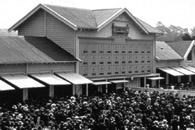
Automatic totalisator
1913
machine for computing bets made on races
George Julius, a university trained engineer working in Western Australia, devised a machine which automated the counting of tickets and calculation of odds and dividends in betting at the racecourse.
Like many Australian innovators, Julius first worked for the government. In the 1890s he designed a 'cheat proof' mechanical vote-counting machine, which was sold to the State of New York, USA, in 1892. No buyers were found in Australia so Julius searched for new applications for his calculator.
He decided that his invention would make a perfect automatic totalisator, a machine to record bets and calculate the changing odds and dividends at the racecourse.
Now working for himself, Julius built a scale model of an automatic, electro-mechanical totalisator in Sydney in 1907. The real thing was first installed at Ellerslie racecourse in Auckland, New Zealand, in 1913. It was so big that it had its own building! This was the first automatic totalisator and replaced a labour intensive non-mechanical system.
For years, Julius' company, Automatic Totalisator Limited (ATL), dominated the design and supply of racecourse betting equipment throughout the world. Julius became the first chairman of the Council for Scientific and Industrial Research (now the CSIRO) in 1926.
Who Did It?
Key Organisations
Automatic Totalisators Ltd : R&D, design, manufacture
Key People
George Julius : inventor
Awdry Julius : designed improvements
Further Reading
The engineers: 200 years at work for Australia
Brian Carroll
The Institution of Engineers Australia, Canberra, 1988, p 130.
Links
Totalisator History
Bright
Sparcs, George Julius
Ellerslie racecourse and
Auckland Racing Club
Victoria Racing Club and the
Melbourne Cup
|











